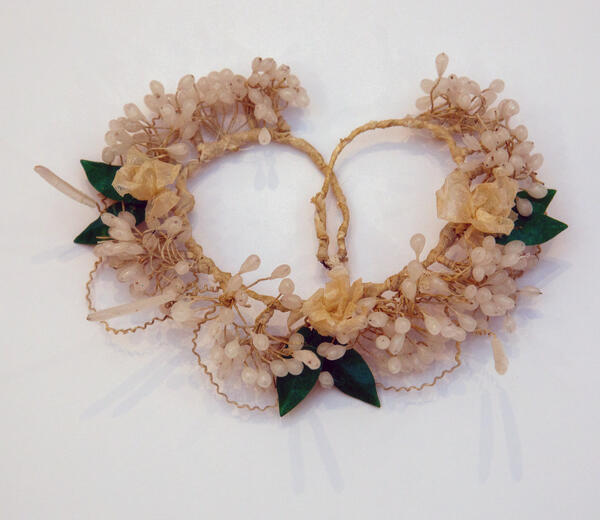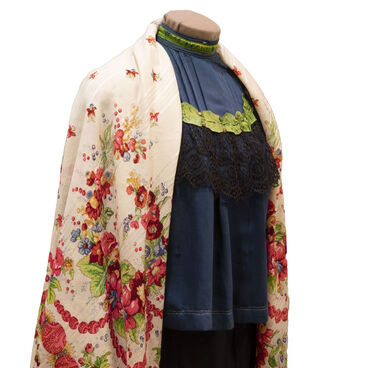A wax wreath was an obligatory element of the bridal attire alongside the wedding dress and was worn during the ceremony. In the Cossack community, this headdress was white. It was decorated with lace, embroidery, pleats, and ruffles. A bridal veil was also an important element, and together with the elegant wreath, it served to symbolize purity and long family life.
Such wreaths were known as “orange flowers” and were extremely popular until the mid-20th century. They were completed by braids of flowers. This trend came to Russia in the early 1700s and originated in Europe where the bride’s symbol was the white orange blossom flower of the Citrus family. However, since orange blossom did not grow in Russia, wedding wreaths were made either of wildflowers or ears of wheat (as weddings often took place in fall), or of artificial materials.
A wedding wreath was a headdress made of paper, cloth, or wax flowers. Such “orange flowers” imitated real buds and flowers and were used to decorate the hair of the bride either on their own or together with a veil made of blonde, an intricate bobbin lace.
The orange blossom set of the 19th century consisted of a wreath, a brooch for the belt or fixing the neckline, and twigs for the sleeves.
Wax flowers for the bridal outfit were prepared by families the day before the wedding or bought at churches and monasteries. Some villages had craftsmen who created such decorations. The technique was rather simple: a stalk of wire and cigarette paper were used to make the base for the frame, as well as various components of flowers, stamens, petals, and leaves. Sometimes, after painting, they were dipped into melted wax, and then used to put the headdress together.
Wreathes were meant for one person only: it was prohibited to hand them over to daughters or lend to friends. After the wedding, the bridal gown was replaced by a dress of a married woman, and the wreath was placed in a kiot, a glass icon shelf, where it was stored throughout her life.
Due to the availability of material and the simple technique, orange blossoms were ubiquitous. The popularity of wax decorations experienced ebbs and flows, until they were almost completely forgotten by the 1980s.
Such wreaths were known as “orange flowers” and were extremely popular until the mid-20th century. They were completed by braids of flowers. This trend came to Russia in the early 1700s and originated in Europe where the bride’s symbol was the white orange blossom flower of the Citrus family. However, since orange blossom did not grow in Russia, wedding wreaths were made either of wildflowers or ears of wheat (as weddings often took place in fall), or of artificial materials.
A wedding wreath was a headdress made of paper, cloth, or wax flowers. Such “orange flowers” imitated real buds and flowers and were used to decorate the hair of the bride either on their own or together with a veil made of blonde, an intricate bobbin lace.
The orange blossom set of the 19th century consisted of a wreath, a brooch for the belt or fixing the neckline, and twigs for the sleeves.
Wax flowers for the bridal outfit were prepared by families the day before the wedding or bought at churches and monasteries. Some villages had craftsmen who created such decorations. The technique was rather simple: a stalk of wire and cigarette paper were used to make the base for the frame, as well as various components of flowers, stamens, petals, and leaves. Sometimes, after painting, they were dipped into melted wax, and then used to put the headdress together.
Wreathes were meant for one person only: it was prohibited to hand them over to daughters or lend to friends. After the wedding, the bridal gown was replaced by a dress of a married woman, and the wreath was placed in a kiot, a glass icon shelf, where it was stored throughout her life.
Due to the availability of material and the simple technique, orange blossoms were ubiquitous. The popularity of wax decorations experienced ebbs and flows, until they were almost completely forgotten by the 1980s.




